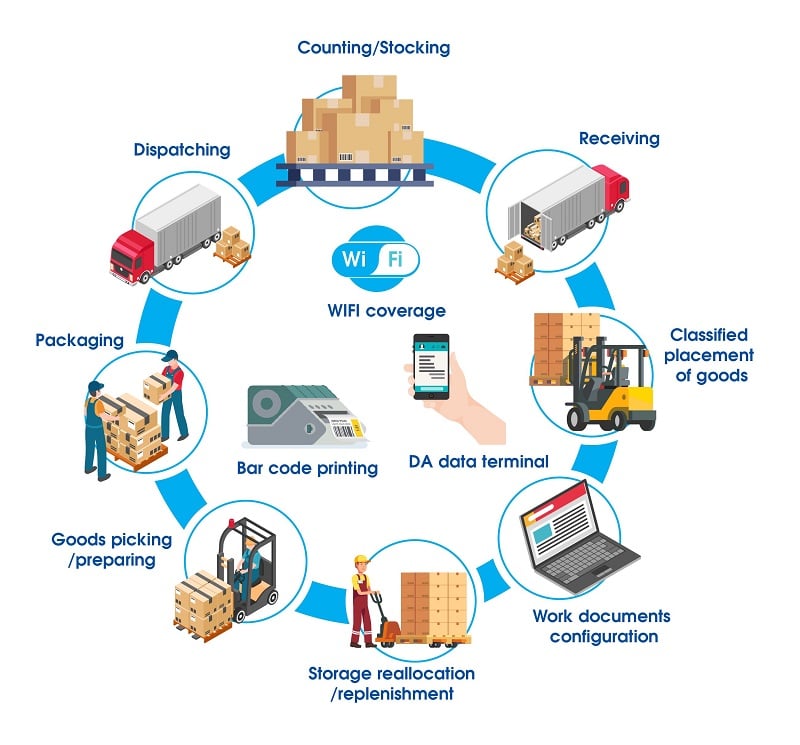Call Us :8615298359310
Call Us :8615298359310
Key Takeaway: In the modern supply chain rat race, efficiency could be the most determining factor of business success. A Warehouse Management System (WMS) is crucial for optimizing warehouse operations, and providing comprehensive control over inventory, order management, and overall warehouse efficiency.
Introduction
A Warehouse Management System (WMS) plays a pivotal role in managing and coordinating daily operations within a warehouse. From tracking inventory to order fulfillment, a WMS ensures that warehouse management is streamlined. In this article, we shall delve into the warehouse activities supported by a WMS, its benefits, and the steps for effective implementation.
Understanding WMS
A Warehouse Management System (WMS) is a software solution designed to oversee the daily operations of a warehouse. It facilitates the management of inventory, order processing, and shipping, ensuring efficiency and accuracy.

Types of WMS:
1. Standalone Systems: The most basic type, often used with a business’s original hardware and software. It handles essential warehouse functions without integrating with other systems.
2. Supply Chain Modules: These focus on automating common tasks and managing relationships with vendors, business processes, and risk assessments.
3. ERP Modules: ERP software integrates the WMS into a broader system encompassing various business functions like supply chain planning, accounting, CRM, and HR.
4. Cloud-Based Systems: Web-based models employing cloud technology, offering faster implementation and lower costs compared to traditional WMS.
Selecting the right WMS depends on your business needs, scale, and budget. Each type offers unique features, and the best choice will align with your operational requirements and future growth plans.
Warehouse Activities Supported by WMS
A WMS supports several critical warehouse activities, ensuring seamless operations and optimal efficiency:
1. Inventory Reception and Tracking
o Reception: The process begins with receiving goods into the warehouse. A WMS tracks incoming shipments, records quantities, and verifies them against purchase orders.
o Storage: After verification, the inventory is stored in designated locations. The WMS assigns optimal storage locations based on factors like item size, demand, and storage conditions.
o Tracking: Continuous tracking of inventory ensures real-time visibility of stock levels, locations, and movement within the warehouse.
2. Order Picking and Packing
o Order Picking: When an order is received, the WMS generates pick lists, guiding workers to retrieve items from their storage locations efficiently. Advanced systems use algorithms to optimize pick paths, reducing travel time and increasing productivity.
o Packing: Once picked, items are packed securely for shipment. The WMS ensures that the correct items are packed and that they meet the required packaging standards.
3. Shipping and Order Fulfillment
o Shipping: The WMS manages the shipping process, including carrier selection, shipment scheduling, and tracking. It ensures that orders are shipped using the most cost-effective and timely methods.
o Order Fulfillment: The system monitors the entire order fulfillment process, from picking and packing to shipping and delivery. It provides real-time updates to customers, enhancing transparency and customer satisfaction.
4. Reporting and Analytics
o Performance Reports: A WMS generates detailed reports on various warehouse operations, including order fulfillment rates, picking accuracy, and inventory turnover. These reports provide insights into operational efficiency and areas for improvement.
o Analytics: Advanced analytics tools within a WMS enable data-driven decision-making. By analyzing trends and patterns, businesses can optimize inventory levels, improve order accuracy, and enhance overall warehouse performance.

Benefits of Implementing WMS
Implementing a WMS offers numerous benefits that significantly enhance warehouse operations:
1. Enhanced Inventory Control and Visibility
o A WMS provides a comprehensive view of inventory levels, locations, and movement. This real-time visibility reduces stockouts and overstock situations, optimizing inventory levels and improving cash flow.
2. Improved Order Management and Accuracy
o By automating order processing, a WMS ensures that orders are picked, packed, and shipped accurately. This reduces errors, minimizes returns, and enhances customer satisfaction.
3. Increased Efficiency and Reduced Human Error
o Automation of routine tasks, such as inventory tracking and order processing, reduces the likelihood of human error. This increases overall efficiency and allows workers to focus on more value-added activities.
4. Scalability and Adaptability
o A WMS can scale with business growth, accommodating increased inventory levels, order volumes, and new warehouse locations. It can adapt to changing market conditions and business requirements, ensuring long-term operational efficiency.
How to Implement WMS Effectively
Effective implementation of a WMS requires careful planning and execution. Here are key steps to ensure a successful WMS implementation:
1. Setting Clear Expectations and Project Scope
o Define project goals, timelines, and deliverables. Ensure all stakeholders understand their roles and responsibilities. Clear expectations and a well-defined scope help manage the project efficiently.
2. Involving Stakeholders and IT Team Early
o Engage key stakeholders, including warehouse managers, IT personnel, and end-users, early in the process. Their input and feedback are crucial for selecting the right system and ensuring smooth implementation.
3. Budgeting for Testing, Training, and Go-Live Phases
o Allocate resources for thorough testing of the system to identify and resolve issues before going live. Provide comprehensive training to ensure that all users are familiar with the new system and its functionalities.
4. Continuous Monitoring and Adaptation
o Regularly monitor the system’s performance post-implementation. Gather feedback from users and make necessary adjustments to optimize operations. Continuous improvement ensures long-term success.
FAQ
What is a WMS?
A WMS, or Warehouse Management System, is a software solution that manages and optimizes warehouse operations, including inventory tracking, order processing, and shipping.
How does a WMS improve warehouse operations?
A WMS enhances warehouse operations by providing comprehensive control over inventory, improving order accuracy, and increasing overall efficiency through automation and real-time data tracking.
What are the types of WMS?
The primary types of WMS include Standalone Systems, Supply Chain Modules, ERP Modules, and Cloud-Based Systems, each offering different features tailored to specific business needs.
How to choose the right WMS for your business?
Selecting the right WMS involves assessing your business requirements, understanding the features offered by different WMS types, and considering factors such as scalability, cost, and vendor support.
What are the common challenges in WMS implementation?
Common challenges include managing project scope, ensuring thorough testing and training, involving key stakeholders early, and adapting to system changes and updates.
Key Takeaways for Businesses
1. Understanding the Role of WMS in Modern Warehousing
o Modern warehouses are complex environments that require sophisticated management tools to ensure efficiency and accuracy. A WMS plays a critical role in managing these complexities, providing the tools necessary to handle inventory, orders, and shipping with precision.
2. Aligning WMS with Business Goals
o The implementation of a WMS should align with broader business goals. Whether it's improving customer satisfaction through faster order fulfillment or reducing costs by optimizing inventory levels, the chosen WMS should support these objectives.
3. Choosing the Right Vendor and System
o Not all WMS solutions are created equal. Businesses must carefully evaluate potential vendors, considering factors such as system capabilities, integration with existing software, vendor support, and scalability. A thorough selection process can prevent costly mismatches and ensure the chosen system meets current and future needs.
4. Ensuring Smooth Implementation
o A successful WMS implementation requires detailed planning and coordination. Clear communication of expectations, involvement of all stakeholders, and thorough testing are essential. Additionally, adequate training ensures that all users are comfortable with the new system and can utilize its features effectively.
5. Continuous Improvement and Adaptation
o Post-implementation, continuous monitoring and adaptation are crucial. Regular feedback from users, combined with data-driven insights from the WMS, can help identify areas for improvement. This ongoing process ensures that the WMS continues to meet the evolving needs of the business.
6. Maximizing the Benefits of WMS
o The full benefits of a WMS are realized when it is fully integrated into the warehouse operations. This includes leveraging advanced features like real-time analytics, automated reporting, and integration with other business systems. By maximizing these capabilities, businesses can achieve significant improvements in efficiency, accuracy, and customer satisfaction.
Final Thoughts
A WMS is not just a tool; it's a cornerstone of modern warehouse management. It transforms how businesses handle inventory, process orders, and fulfill shipments, driving improvements in every aspect of warehouse operations. For businesses looking to stay competitive and meet the demands of today's market, investing in a robust WMS is a must. To evaluate if it’s time to purchase your WMS System, you’re welcomed to contact our experts from vison storage team.
Copyright © 2024 Jiangsu VISON Logistics Technology Co., Ltd. All Rights Reserved.  Network Supported
Network Supported
Sitemap | Blog | Xml | Privacy Policy